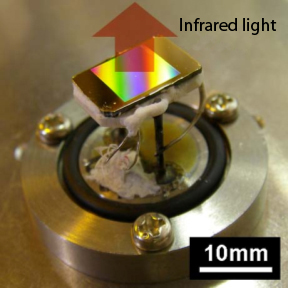Success in the Development of a Novel Infrared Light Source Using Plasmon Resonance
Nanostructure Control of Thermal Radiation Opens the Way to High Efficiency Environmental Measurement
National Institute for Materials Science
A team led by Senior Researcher Hideki Miyazaki of the Quantum Dot Research Center of the National Institute for Materials Science, in joint work with a team headed by former Researcher Satoshi Ikeda of Nalux Co., Ltd. succeeded in the development of a novel infrared light source using plasmon resonance of gold.
Abstract
A team led by Senior Researcher Hideki Miyazaki of the Quantum Dot Research Center (Managing Director: Kazuaki Sakoda) of the National Institute for Materials Science (President: Prof. Teruo Kishi), in joint work with a team headed by former Researcher Satoshi Ikeda of Nalux Co., Ltd. (Representative Director: Seiichiro Kitagawa) succeeded in the development of a novel infrared light source using plasmon resonance of gold.
Analytical methods using infrared light play an important role in environmental measurements to investigate the concentrations of CO2 and nitrogen oxides (NOX) in the air and harmful substances in liquids. However, in the conventional analytical method, only two wavelengths of infrared light were extracted from the light from a black body light source, which includes a wide range of radiated wavelengths. This is inefficient, in that a large part of the power input was consumed in radiation of unnecessary light. Light-emitting diodes, lasers, and other devices which are capable of radiating only the necessary wavelengths of infrared light are still rarely used due to problems of output and cost in the infrared region above wavelengths of 2.5 micrometers, which is useful in environmental measurements. Therefore, the development of a new infrared light source that enables high efficiency environmental measurement had been desired.
The infrared light source developed in this research is a thermal radiation light source in which nano-sized grooves are made periodically in a gold surface. When the gold surface with these grooves is heated, only infrared light of the designated wavelength is radiated with good efficiency by the plasmon resonance which occurs in the grooves. This wavelength can be set as desired by controlling the groove width, depth, and period. Furthermore, because the infrared light radiated from this light source is linear polarized light, it is possible to radiate infrared light of the two wavelengths necessary in analysis as orthogonal polarized light by integrating two types of periodic grooves on one light source in such a way that the grooves are mutually orthogonal. Utilizing the fact that polarization-splitting of orthogonal polarized light is easily achieved, the researchers succeeded in measuring the concentration of an organic solvent mixed in a liquid using a prototype two-wavelength light source.
Because the developed infrared light source is suitable for manufacture by transcription, low cost mass production by duplication from a die can be expected. Because this light source converts input electric power only to infrared light of the wavelengths necessary in analysis, and does not consume power in wasted radiation like conventional black body light sources, it is particularly useful as a light source for battery-powered portable environmental measurement devices. With progress in nanostructure production technologies, the phenomenon of heat radiation, which did not seem to be possible to modify artificially, has become an object of complete human control.
The results of this research are scheduled to be published in the January 21 issue of Applied Physics Letters.

Fig. : Newly-developed infrared light source. The rainbow-colored area is the infrared light radiating surface with periodic grooves.